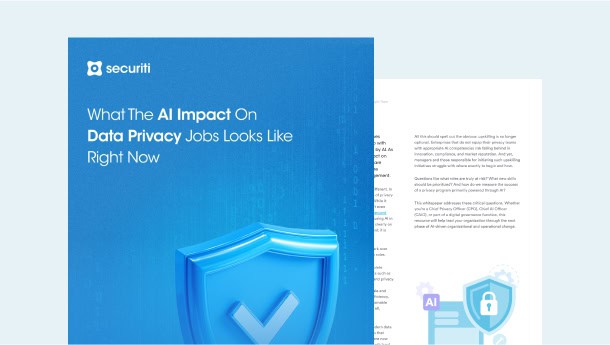As your business grows, you'll undoubtedly need to outsource some tasks. Every expanding company needs third and even fourth-party suppliers, whether for purchasing supplies from external manufacturers or outsourcing individuals to assist your marketing efforts.
Vendor Risk Management (VRM) is a process concerned with managing and keeping track of risks brought on by third-party providers of information technology (IT) goods and services. VRM aims to control and prepare for third-party risk and avoid any disruption to business performance. A VRM program's goal is to offer a management framework for identifying, quantifying, monitoring, and reducing the risks associated with vendor management.
What is Vendor Risk Management?
Vendor risk management is a principle that is dedicated to identifying and reducing risks concerning third-party vendors. Organizations may see which vendors they may want to interact and collaborate with and whether these vendors have established adequate data privacy functions and security controls within their organizations.
Strategies for managing vendor risk contain a thorough approach to identifying and minimizing business risks, legal obligations, and reputational harm. Organizations can identify and assess any possible risks associated with collaborating with a vendor during this process.
After that, organizations can make a sound decision regarding whether the benefits of the alliances outweigh the risks. This decision-making process is based on an organization's policies, practices, mission, goals, and needs.
Why is Vendor Risk Management Important?
VRM and third-party risk management become a more vital component of any corporate risk management framework as organizations engage in outsourcing more frequently. This way, organizations can delegate additional tasks to external vendors and concentrate on what they do best.
Even though collaborating with a third party can help an organization operate more efficiently and reduce operational costs, it also introduces significant risks. With the increase in cyberattacks and organizations facing increased losses, it’s clear that a robust framework is needed to ensure minimal risk levels.
Regardless of an organization’s size or location, cyberattacks have influenced millions of businesses and their third parties. Having a robust VRM system in place helps your organization to effectively detect and manage potential risks associated with the delegation of tasks to third parties.
The effects of unforeseen vulnerabilities can be lessened, and a company's overall risk exposure can be decreased with an efficient VRM program. Organizations that have adopted a vendor risk management program, for instance, can better assess and onboard new vendors, putting the necessary resources in the hands of the right people more quickly.
A vendor risk management framework also enables organizations to track their interactions with vendors over time, identify evolving risks as they materialize, and evaluate vendor performance. Other factors supporting the significance of vendor risk management process include the following:
- Enforces obligations on suppliers.
- Identifies unnecessary third parties to cut costs.
- The ability to comply with evolving international laws and standards and business requirements.
- Gives transparency into data streams and data access.
- Ability to evaluate security measures and oversee risk reduction actions.
- Discard unnecessary vendors and keep records for compliance.
What Are the Different Types of Third-Party Vendor Risks?
When organizations work with other parties, they run several risks. There are different third-party vendors that provide a variety of different services. These include suppliers, manufacturers, freelancers (Software as a Service (SaaS) providers or marketeers), contractors, consultants, etc. Among these, vendors who handle sensitive, proprietary, private, or otherwise confidential information on an organization’s behalf carry a higher risk.
No matter how effective an organization’s internal security measures are, organizations could still be at much risk if third-party providers have bad security practices. The following are the common types of vendor risks:
Compliance and legal risk, commonly known as regulatory risk, arise when an organization’s business activities violate laws, industry practices, or regulations. These rules must also be reflected in the internal policies and processes of the organization. Laws are constantly evolving and vary from industry to industry. Depending on the type of vendor and the task outsourced to them, different laws and regulations apply. It's crucial to ensure vendors follow the relevant laws, rules, regulations, policies, and ethical standards because non-compliance can lead to significant fines.
The public's impression of your organization matters significantly because it can influence customers and your entire business. Third-party vendors can harm an organization’s reputation in several ways, including interactions that don't meet your company's standards, handling any sensitive data with carelessness, or failure to comply with legal and regulatory requirements.
Financial risk, also called credit risk, typically occurs when vendors cannot deliver adequate and agreed performance as stated in the contract or when the vendor is at risk of insolvency or other circumstances that may cause the vendor operations to disrupt. Financial risks result in increased costs and lost revenue. Frequent vendor audits can help assure that they are spending following the parameters set forth.
Cyber dangers are ever-evolving and changing. It's more crucial than ever to manage increasing cyber risks as they become more sophisticated. Not all third-party suppliers have the same level of risk. Therefore, it's critical to recognize and assess which third parties require more attention and resources. Organizations should also specify what they consider an acceptable risk level.
Additionally, it’s essential to carry out risk assessments such as vendor risk assessment comprising vulnerabilities existing within the vendor ecosystems and whether those vulnerabilities can compromise an organization’s integrity.
How to Identify a Vendor Breach?
Ensuring your organization’s infrastructure and online presence are secure is no longer a straightforward process. If an organization has multiple vendors, the stakes are high. Vendors are no strangers to having their operations exposed to wrong configurations or becoming the target of cybercriminals. Vendor risks should be strategized to ensure minimal to no vulnerability.
A vendor breach occurs when a third-party vendor that has your organization’s confidential data is compromised, and systems are used to obtain illegal access to your systems. Here are some signs that may conclude that your vendor has been breached:
- The vendor lacks security safeguards in place and has been breached before.
- The vendor is not transparent about its security safeguards.
- The vendor sends suspicious emails such as password reset or emails containing irrelevant details/attachments.
- The vendor is not responding to your queries.
- The vendor’s official website has gone down, and no clarity has been given.
How to Conduct a Vendor Risk Assessment?
Vendor risk assessments can be carried out through a questionnaire like a vendor risk assessment or third-party risk assessment. The assessment aims to assess and investigate the organization’s present and potential vendors.
This is conducted by assessing a vendor's security controls, values, objectives, policies, practices, and other key aspects. These should then be gauged against the regulations, and best practices of the industry vendor’s products fall into. Organizations can then determine if the benefits of partnering with the third party exceed the risks.
How Do Companies Manage Vendor Risk?
Organizations that primarily rely on vendors but lack visibility into their vendor networks run a high risk of exposure. This gives birth to various risks, and managing vendor risk is essential for the continued business operations of any organization.
Managing vendor risk involves the creation of a vendor risk management checklist that might include items such as:
- Regular audit of the kinds of employee or customer data that each vendor needs access to and limiting access levels where and as needed.
- Examine the contracts and policies of each vendor to determine whether they comply with the organization’s own rules and industry standards. If they’re not, the organizations can require the vendor to make adjustments if necessary.
- Examine each vendor's cybersecurity procedures to see if they adhere to industry standards and the organization’s own policies.
- Analyze the extent of the potential impact on the organization’s business or customers in the event of a vendor breach and decide whether mitigating measures may be required.
- Examine the incident response plan for each vendor.
- Review the business continuity strategy of each vendor.
What is a Vendor Risk Management Lifecycle?
The entire method businesses use to manage their vendors in a structured and open way is known as the vendor management lifecycle. Vendor lifecycle management places a third-party vendor at the center of the procurement process, thereby allowing businesses to get the most out of the partnership while minimizing vendor risks. Organizations must fundamentally restructure their conventional supplier management methods to save money and lower risk as methods evolve with time.
The vendor management lifecycle enables organizations to understand the true potential of their vendors and include them in their sourcing strategies. The vendor risk management lifecycle comprises:
- Identification
- Vendor Selection
- Segmentation
- Onboarding
- Performance Management
- Vendor Risk Management
- Contract Management
- Offboarding
What is a Vendor Risk Management Maturity Model (VRMMM)?
A vendor risk management maturity model (VRMMM) is a comprehensive methodology for assessing the level of maturity of third-party risk management programs, including controls for data security, cybersecurity, and information technology. It allows businesses to evaluate the third-party vendor’s provision of services and products against the established rules as per industry practices and regulatory frameworks.
With a VRMMM, organizations can plan their approach before launching a program. Any VRMMM must include these two crucial components:
- A method for determining and assessing requirements and risks, and
- Determine how each department manages risks, where resources need to be relocated, and what may be improved to gauge the relative growth of maturity in components of the overall risk management framework.
How to Create an Effective Vendor Risk Management Program?
By using the steps below, organizations may create effective vendor risk management programs:
Write Vendor Risk Management Documentation
The relevant vendor risk management paperwork must be developed by the organization and included in the information security policy.
Establish Vendor Selection Standards
Although a vendor may be internally compliant with regulatory obligations, this may not apply to its clients. Before establishing new vendor partnerships and trusting them to secure your data, you must ensure your security team has a successful method for screening third parties.
Conduct Due Diligence on Vendors
Vendor due diligence, which entails evaluating potential vendors before onboarding, is vital in the vendor selection process. The vendor's statements regarding its security posture, certifications, and degree of compliance should be verified through due diligence.
Conduct Regular Vendor Audits
Organizations might find compliance weaknesses and gaps by conducting routine audits after due diligence. An organization's vendor ties should be thoroughly reported during audits, and security questionnaires should be used to monitor compliance.
Establish Expectations for Reporting
Reporting should include standard cybersecurity metrics that summarize the key elements of the risk portfolios of your significant vendors and be easily understood by all stakeholders.
How Securiti Can Help You Manage Your Vendor Risk?
Securiti specializes in Third-Party Risk Management, Privacy, Incident Management , and many other categories to deliver an immersive security and privacy management experience.
With Securiti, organizations can reduce vendor or third-party risk by conducting a Vendor Risk Assessment. Organizations can invite and assess their vendors in one system, track progress, collaborate, and maintain a centralized system of record.
Organizations can access the Securiti research team's impartial analysis of a vendor's privacy and security policies with a score-based system. The vendor's security procedures, current security certifications, and privacy procedures contribute to the final score.
Request a demo today.






































